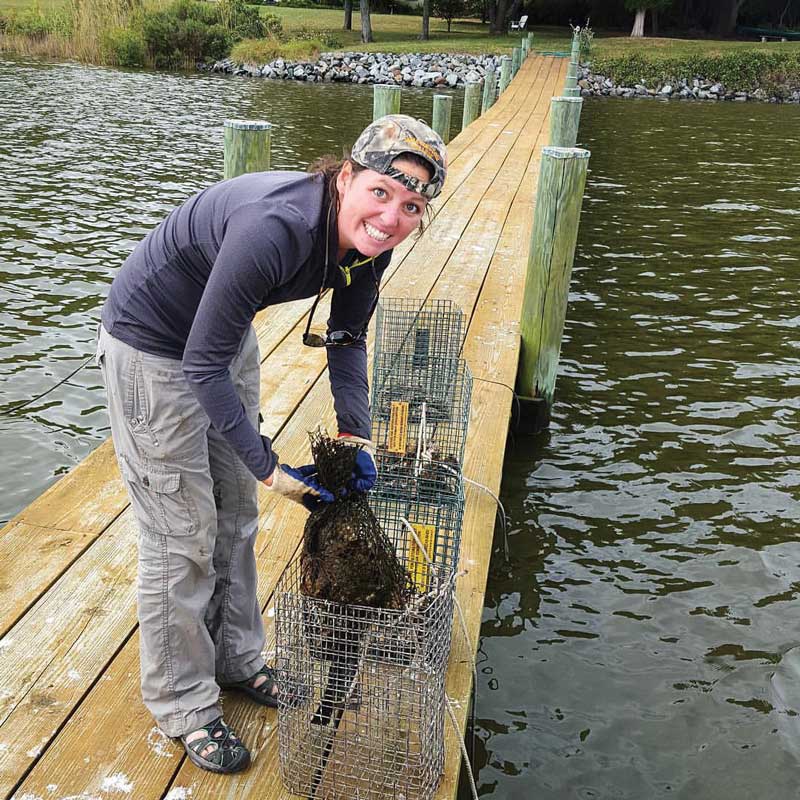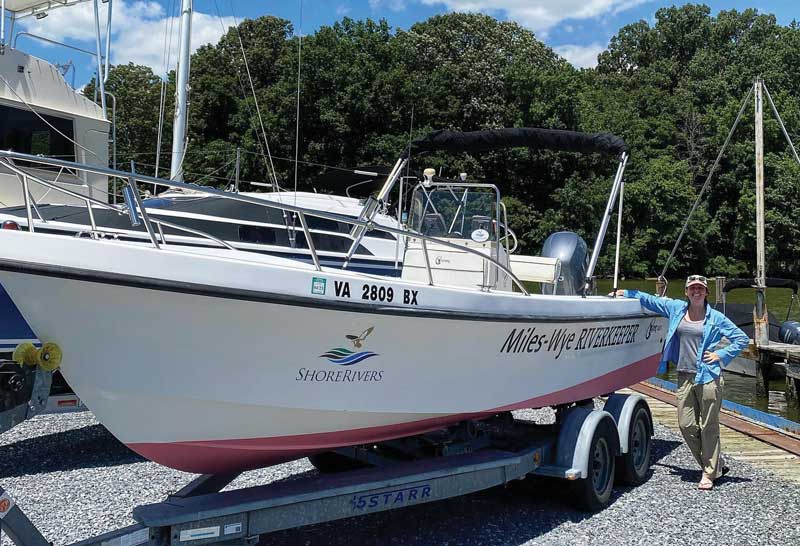Chesapeake Bay native Elle Bassett shares how she became a riverkeeper and what she loves about her job.

Family time on the water
I grew up on the South River near the mouth by Thomas Point Lighthouse. I was introduced to boating through my dad, a sport fisherman. He had an old-school Trojan when I was young, and I vividly remember the wood paneling and bunks in the cabin. He now has a Pursuit, and I often get to join him for summer raftups on the river or for fishing adventures including the annual Boatyard Opening Day Rockfish Tournament.
I became a mom last March, so I am looking forward to taking my son out with his grandpa this summer. When I’m out on the water for fun, I am a frequent visitor of St. Michaels Harbor. Some of my other favorite spots on the river include the heron rookery in upper Wye East and the Wye Island bridge on the Wye Narrows.
What’s the best part of your job as a Riverkeeper?
Besides the obvious—being able to call the river my “office” on some days—the best part of my job is having the creative freedom to protect and restore the river in different ways. Being a riverkeeper means I get to wear a lot of different hats.
On any given day I might be in a classroom or taking students to the river on a field trip, in a field planting trees, on the river taking samples, or in Annapolis advocating to elected officials. It is an ever-evolving job that lets me meet people where they are and discover what connects them to the river. It is never dull.
I once found myself in the middle of a huge dolphin pod at the mouth of the Wye River with at least 50 dolphins surrounding my riverkeeper boat. It was amazing. I also always get a thrill of seeing a storm come in while on the river—perhaps not in the exact moment when I’m hauling to get back to the dock— but you can’t deny that seeing a white-out from rain coming across the river is just so cool.

Advice for an environmental career
I wanted to be a high school English teacher when I enrolled in Washington College in Chestertown, MD, until I took an environmental science class to meet a credit requirement. I was hooked. I never really realized it was possible that I could take my joy of being on the river as a kid and turn it into a career.
I would advise students today to be open to new ideas. Even if you take a class and you realize you don’t like it, that is still a great learning experience in knowing what you want or don’t want in a future career. I knew that I wanted to end up in a career that made me excited and happy to go to work. Take the time to find that in your classwork.
Environmental fields are coming more to the forefront as we realize what is happening to our environment and that we can’t ignore climate change anymore. We need future generations to be invested in it, and now there are so many environmental careers: law, energy, resource management, architecture. What an exciting time for a student to be starting an environmental career!
It’s a year-round job
Our outdoor programs are most active April through October. During those months, I’m on the river at least once a week for water quality monitoring. I measure temperature, salinity, dissolved oxygen, clarity, algae, and nutrients at 20 site locations through the Miles and Wye Rivers and Eastern Bay. I also monitor for submerged aquatic vegetation (SAV) on the water, measure bacteria during the swimming season, assist with oyster restoration, and patrol for sediment or shoreline violations on the water.
Our data analysis season is heaviest during the winter, and our legislative work is most active between January and April. The desk work is just as essential as the field work. A part of my job is bringing restoration and outreach projects to my watershed, which involves grant writing. I also spend a good chunk of time working on outreach pieces, such as monthly e-newsletters and presentations for the public and producing report card documents that inform the public on the state of our rivers. I get a thrill working on a new way to protect or restore the river and then writing a grant to make it happen. Through funding opportunities, I can bring new projects to the watershed.
Life off the water
I am a proud member of an all-women Appalachian Trail hiking group that hikes a section in a new state each year. The six of us all met through work and have hiked sections in Pennsylvania, Vermont, New York, Georgia, Massachusetts, West Virginia, and Virginia. At the end of the trip, usually after about 30 brutal miles and two nights, we pick the next year’s state out of a hat. We’re headed to Maine this year. I look forward to it every year for many different reasons—to lose myself in the vastly different mountain landscapes compared to the flat Eastern Shore, to push my mental and physical boundaries, and to reconnect with my network of other strong women in the environmental field. My trail name is Navigator (Nav for short) as I am the keeper of the trail maps (and must know what mile I am on every step of the way).
As Told to Beth Crabtree